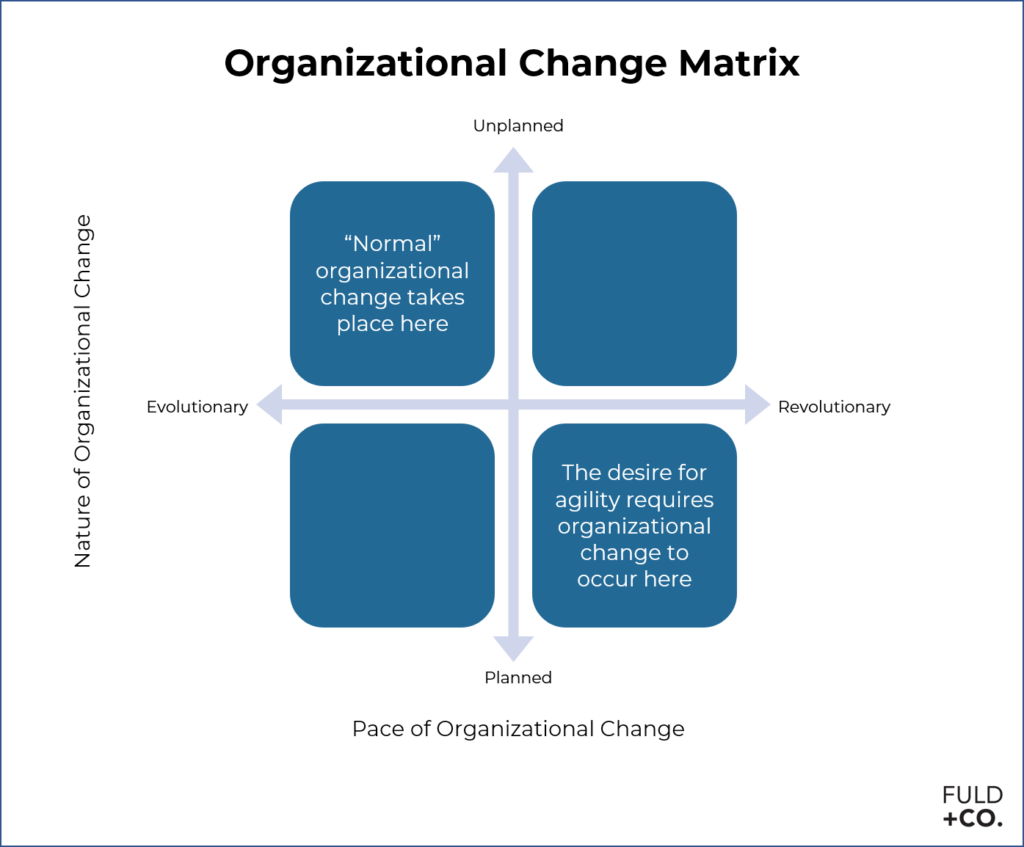An Agility Roadmap for Organizations Adapting to Change
Posted by | Fuld & Company
Fuld & Company delivered an interactive workshop on organizational change and achieving agility at the ‘Work Reimagined Conference,’ by Nimbus Ninety, in London
Organizations strive for many things, and flexibility is one of them. Businesses of all sizes strive to be agile, because doing so helps them react quickly to shifts in the external environment and adjust to unforeseen circumstances that impact their performance. Considering that today’s environment is defined by constant transformation and the omnipresent risk of disruption; from forces such as technology advancements, regulatory changes and automation, organizations must remain nimble to position more effectively than competitors as market conditions evolve.
Despite this desire for agility, few organizations have the knowledge or planning skills to truly achieve it.
The mistake most organizations make on their quest to achieve increased agility starts when they look at internal systems, processes, and organizational models, when instead, the agility journey should start with an assessment of external forces. Evaluating external forces gives organizations a more informed view of what is driving their need for agility in the first place.
For further consideration, it’s critical to note that organizations are built on human systems and as such, change does not come easy, nor predictably. Most organizational changes tend to be evolutionary rather than revolutionary and are usually unplanned. Of course, there are the inevitable fluctuations organizations experience—standard turnover rates, employees’ career advancements and growth spikes; all of which contribute to changes in organizational structure. Typically, these are misaligned with external developments, and if managers hastily rush to achieve improved agility without considering the external and solely focus on internal matters, organizational transformation may very well occur, but for the wrong reasons.
Before making an ill-informed decision to pursue agility, organizational leaders must first ask themselves: why do we actually have a desire for more agility?
- Is the organization increasingly hard-pressed to react to external stimuli?
- Is organizational learning stifled by an inability to recognize external change?
- Do systems and processes seem disjointed from the needs of customers, suppliers, and other external stakeholders?
If the answer to any of these questions is “no,” we’d recommend leaders reconsider if agility is an outcome worth striving for. Instead of striving for agility, organizations may have different needs stemming from a shift in talent, organizational structure, or some other transformation that yields an outcome other than agility. If, however, managers sense that their organization is fighting to stay current with shifts in external market structures and conditions, then agility may well be a goal worth pursuing.
Keep in mind, too, that most organizational efforts, including those intended to increase agility, fail. Why? At its most basic level, organizational change involves cultural change, and changing organizational culture is complex and often cannot be dictated or forced. Furthermore, many leaders often fail to communicate a positive case for change and embark on change management efforts without a clear statement that includes the reasoning behind those efforts. Finally, obtaining a basic understanding of how to plan for and implement change is difficult, mainly because human systems are highly variable, even within the same industry or geographic market.
Fundamentally, there is a disconnect between how managers want to implement organizational change, and how change actually occurs. Leaders can think of organizational change depicted on a matrix that balances the planned or unplanned with the pace of change identified as either evolutionary or revolutionary.

The clear take-away from this plotting of organizational change is that actual change happens in ways diametrically opposed to how business leaders want change to happen.
Organizations are created and managed based on an assumption of continuity. However, the external environment is not continuous in the same sense that organizations are. The external environment is highly discontinuous, especially as the speed of disruption has intensified. As a result, managers must take a more thoughtful approach to building an agility roadmap, and they must start by looking outside the organization. There are specific actions organizations can take that help them to assess which steps must be taken to reach their agility goals.
John Kotter, in his seminal book Leading Change, spells out eight distinct steps for achieving organizational change.
While we’re Kotter’s fans, and believe the eight steps are a good starting point, we still must remember that change efforts are rarely linear and predictable. Planned, revolutionary change efforts – the only kind likely to result in rapid increased organizational agility – will have their share of setbacks, surprises, and slowdowns. Managers leading change efforts must approach their path to agility with a realistic mindset, and prepare for a “two steps forward, one step backward” experience.
To build a more manageable process when change is imminent, organizational leaders should answer the following questions in addition to answering whether or not agility the right organizational change goal, or should we be striving for some other outcome.
- How can I best communicate our need to be agile?
- How can I underscore external developments to create a sense of urgency for change?
- Which organizational structures have proven effective during change, and are they currently available to my organization?
- Am I prepared to sacrifice organizational stability for increased agility?
- Is our organization resilient enough to thrive in an era of constant disruption?
Overall, simply dictating that an organization needs to “be more agile” is insufficient and lacks the thorough analysis needed to drive and sustain change. Leaders must start by understanding the external stimuli that create their yearning for improved agility, and then they need to make a strong case for change, and be prepared for a messy, non-linear journey.
Tags: Change Management, Competitive Advantage, Competitive Strategy, Consumer Products & Retail, Energy, Events, Financial Services, Healthcare & Life Sciences, Human Resources, Leadership, Modern Workplace, Other Industries




















